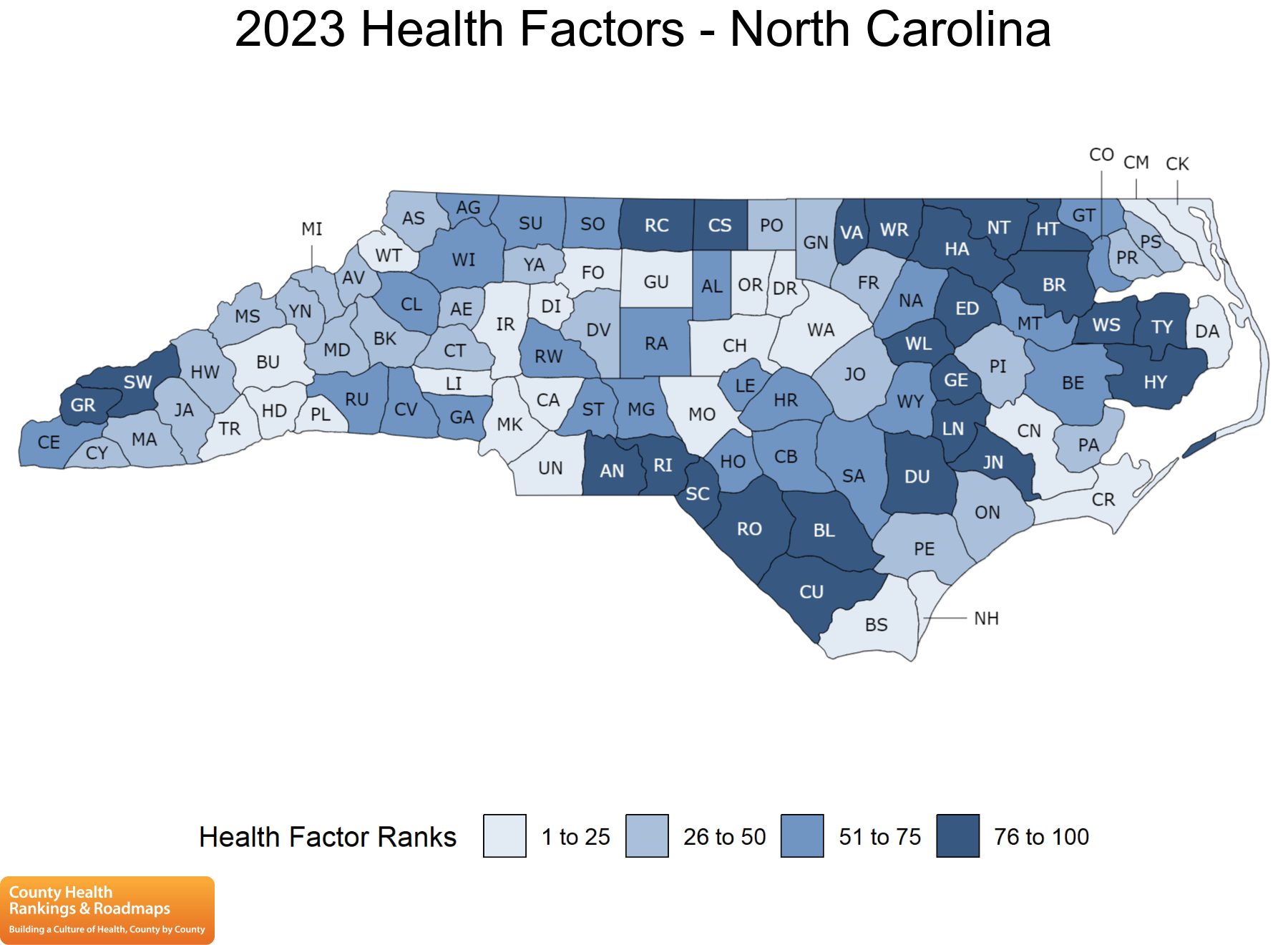State of NC Health
North Carolina ranked as the 30th healthiest state in the nation in 2022. It ranked 38th in health behaviors, 30th in health outcomes, 22nd in socioeconomic factors, and 9th in physical environment (air and water quality, housing, transit).

The Challenge
According to America’s Health Rankings, North Carolina was the 30th healthiest state in the nation in 2022 (United Health Foundation, 2023). Strengths include relatively low levels of frequent mental stress, black/white residential segregation, and air pollution. Challenges include a relatively high premature death rate, a low supply of dental care providers, and a high uninsured rate. The North Carolina Department of Health and Human Services is focusing on three priorities through 2024: investing in behavioral health and resilience, supporting child and family well-being, and building a strong and inclusive workforce.
Watch our PBS NC ncIMPACT show and read our blog on Improving Mental Healthcare Access to explore more about this topic.

Potential Responses
Short-Term
- Develop, update, and maintain Community Health Improvement Plans (CHIPs) detailing specific strategies, actions, and a monitoring program to address health priorities identified in Community Health Assessments (CHAs)
- Form cross-sectoral working groups to address identified health priorities
- Research best practices employed by comparable urban, suburban, and rural communities in North Carolina and across the country
- Implement pilot initiatives to address selected priorities, focusing on reducing health disparities and improving outcomes for disadvantaged populations
Medium-Term
- Implement strategies and actions addressing identified health priorities
- Scale up and expand pilot initiatives, with a continued focus on improving health equity
- Leverage partnerships and resources to address priorities that cut across traditional silos (sectors, jurisdictional boundaries, etc.)
- Use indicators/measures of success to track progress toward addressing health priorities
Long-Term
- Pursue coordinated action at the regional and local levels to realize a long-term vision of community health (universal access to health care; economic security and availability of well-paying jobs; decent, affordable housing for all; walkable environments; access to healthy foods, etc.)
- Monitor implications of other drivers of change (e.g., new technologies) for the social determinants of health in rural, suburban, and urban contexts
Key Stats
- The Centers for Disease Control and Prevention (CDC) estimates that 90% of the $4.1 trillion spent every year on health care in the United States is for people with chronic and mental health conditions. Obesity affects 20% of children and 42% of adults, costing the U.S. healthcare system nearly $173 billion/year (CDC n.d.)
- North Carolina ranked as the 30th healthiest state in the nation in 2022. It ranked 38th in health behaviors, 30th in health outcomes, 22nd in socioeconomic factors, and 9th in physical environment (air and water quality, housing, transit) (United Health Foundation, 2023)
- North Carolina has significant racial and geographic health disparities. For example, African American babies are 2.4 times more likely to die than white babies; African Americans are 2.3 more times likely to die from diabetes than whites; and life expectancy ranges from 73.1 years for Swain County to 82.1 years for Orange County (North Carolina Institute of Medicine 2020)

Source: https://www.countyhealthrankings.org/explore-health-rankings/north-carolina/data-and-resources
Examples: Graham County, Guilford County
The third-least populous county in the state (2020 population of 8,030), Graham County has been a leader among small, rural counties in developing and updating its CHA and CHIP on a regular cycle dating back to at least 2008. The 2013 CHIP provided a good model identifying goals, strategies, action plans, partners, and indicators to address priorities identified in the 2012 CHA. The most recent (2021) CHA identifies Mental Health & Substance Use and Obesity & Heart Disease as its top health priorities and identifies the next steps to address them. Completed in 2022, the most recent CHIP was developed as an interactive Scorecard focusing on the priorities. The Scorecard provides results (desired outcomes, stated as conditions of well-being), strategies, indicators, and performance measures to track how well strategies are working, and annual reports/updates.
Guilford County completed its CHA in 2019. Partners engaged in this effort included UNC Greensboro, United Way, local health providers, and nonprofit health organizations. Priority health issues include Maternal and Child Health, Healthy Eating and Active Living, Behavioral Health (Mental Health and Opioid Misuse), and the Social Determinants of Health (including Healthy Housing). Like Graham County, the Division of Public Health maintains a Healthy NC 2030 Scorecard for Guilford County that serves as its CHIP. The Scorecard provides a result statement, progress indicators (linked to Healthy NC 2030 indicators), programs/activities, and performance measures demonstrating the impact of each health priority.
Click here to complete our survey about North Carolina health drivers!
References
Artiga, Samantha and Elizabeth Hinton (2018). Beyond Health Care: The Role of Social Determinants in Promoting Health and Health Equity. San Francisco: Kaiser Family Foundation.
Centers for Disease Control and Prevention (n.d.). Health and Economic Costs of Chronic Diseases.
Graham County (2013, 2021, 2022). 2013 Community Health Improvement Plan, 2021 Community Health Assessment, 2021 Community Health Improvement Plan.
Guilford County (2019). Community Health Assessment.
North Carolina Institute of Medicine (2020). Healthy North Carolina 2030: A Path Towards Health.
United Health Foundation (2023). America’s Health Rankings: 2022 Annual Report.
University of Wisconsin Population Health Institute (2023). County Health Rankings & Roadmap.
Statista Research Department (2023). Health and health systems ranking of countries worldwide in 2021.
